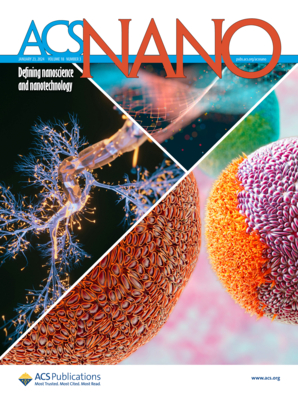Dimension Engineering of Boron Nitride Nanostructures through Catalytic Flash Joule Heating.
IF 16
1区 材料科学
Q1 CHEMISTRY, MULTIDISCIPLINARY
引用次数: 0
Abstract
Boron nitride (BN) is well-known for its excellent thermal conductivity, high chemical stability, and low dielectric constant, making it widely used as a lubricant, thermal management material, and electrical insulator. For different applications, the nanostructure of BN plays a prominent role. In particular, boron nitride nanotubes (BNNTs) are preferred for enhancing the properties in specific directions. Traditional BNNT synthetic methods often require valuable precursors and catalysts and prolonged reaction time for structure engineering, limiting their practical applications. Here, we present a dimension engineering strategy to controllably synthesize one-dimensional BNNTs and two-dimensional nanosheets (BNNSs) by flash Joule heating (FJH) within 1 min. The scalable production of ∼5 g is achieved per batch. During BN synthesis, sulfur is identified as a crucial additive that accelerates precursor dehydration and facilitates nanotube formation. When applied as additives in composites, BNNTs exhibit enhanced mechanical strength and thermal conductivity compared to BNNSs, highlighting the necessity of BN dimension engineering for diverse applications. This work offers a feasible strategy for tailoring BN nanostructures and optimizing their properties, with potential applicability in the synthesis of other nanomaterials beyond BN.催化闪蒸焦耳加热制备氮化硼纳米结构的尺寸工程。
氮化硼(BN)以其优异的导热性、高的化学稳定性和低介电常数而闻名,被广泛用作润滑剂、热管理材料和电绝缘体。在不同的应用中,BN的纳米结构起着突出的作用。特别是氮化硼纳米管(BNNTs)在特定方向上的性能增强是首选。传统的BNNT合成方法往往需要昂贵的前驱体和催化剂,并且在结构工程中需要较长的反应时间,限制了其实际应用。在这里,我们提出了一种尺寸工程策略,通过闪光焦耳加热(FJH)在1分钟内可控地合成一维BNNTs和二维纳米片(BNNSs)。每批可扩展生产约5克。在氮化硼合成过程中,硫被认为是加速前驱体脱水和促进纳米管形成的关键添加剂。当作为复合材料添加剂使用时,与BNNSs相比,BNNTs表现出更高的机械强度和导热性,突出了BN尺寸工程在不同应用中的必要性。这项工作为定制BN纳米结构和优化其性能提供了一种可行的策略,在合成BN以外的其他纳米材料方面具有潜在的适用性。
本文章由计算机程序翻译,如有差异,请以英文原文为准。
求助全文
约1分钟内获得全文
求助全文
来源期刊

ACS Nano
工程技术-材料科学:综合
CiteScore
26.00
自引率
4.10%
发文量
1627
审稿时长
1.7 months
期刊介绍:
ACS Nano, published monthly, serves as an international forum for comprehensive articles on nanoscience and nanotechnology research at the intersections of chemistry, biology, materials science, physics, and engineering. The journal fosters communication among scientists in these communities, facilitating collaboration, new research opportunities, and advancements through discoveries. ACS Nano covers synthesis, assembly, characterization, theory, and simulation of nanostructures, nanobiotechnology, nanofabrication, methods and tools for nanoscience and nanotechnology, and self- and directed-assembly. Alongside original research articles, it offers thorough reviews, perspectives on cutting-edge research, and discussions envisioning the future of nanoscience and nanotechnology.
 求助内容:
求助内容: 应助结果提醒方式:
应助结果提醒方式:


